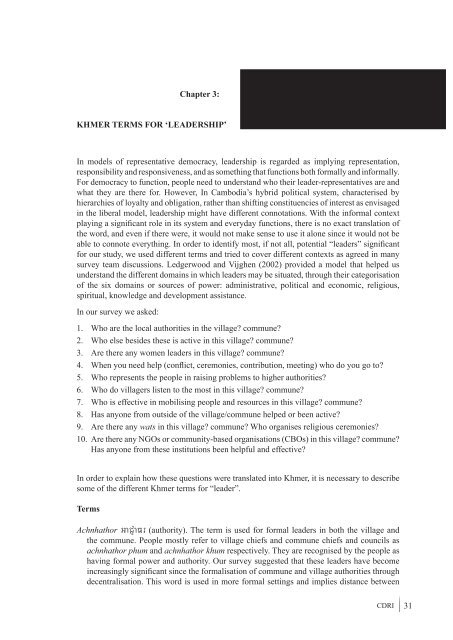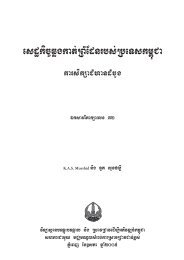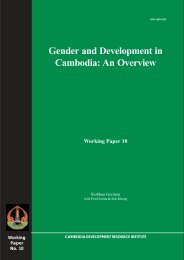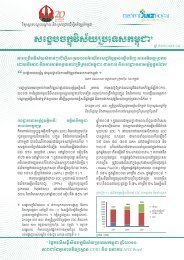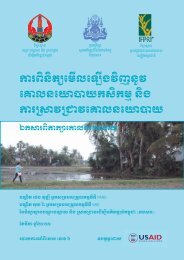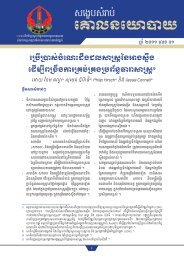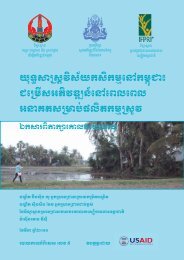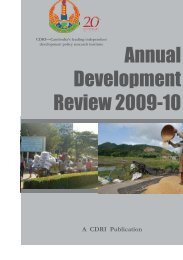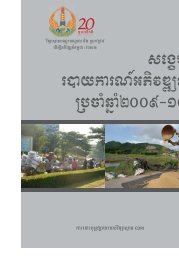Leadership in Local Politics of Cambodia: A Study of ... - CDRI
Leadership in Local Politics of Cambodia: A Study of ... - CDRI
Leadership in Local Politics of Cambodia: A Study of ... - CDRI
You also want an ePaper? Increase the reach of your titles
YUMPU automatically turns print PDFs into web optimized ePapers that Google loves.
Chapter 3:<br />
KHMER TERMS FOR ‘LEADERSHIP’<br />
��������������������������������<br />
In models <strong>of</strong> representative democracy, leadership is regarded as imply<strong>in</strong>g representation,<br />
responsibility and responsiveness, and as someth<strong>in</strong>g that functions both formally and <strong>in</strong>formally.<br />
For democracy to function, people need to understand who their leader-representatives are and<br />
what they are there for. However, In <strong>Cambodia</strong>’s hybrid political system, characterised by<br />
hierarchies <strong>of</strong> loyalty and obligation, rather than shift<strong>in</strong>g constituencies <strong>of</strong> <strong>in</strong>terest as envisaged<br />
<strong>in</strong> the liberal model, leadership might have different connotations. With the <strong>in</strong>formal context<br />
�������������������������������������������������������������������������������������������������<br />
the word, and even if there were, it would not make sense to use it alone s<strong>in</strong>ce it would not be<br />
��������������������������������������������������������������������������������������������������<br />
for our study, we used different terms and tried to cover different contexts as agreed <strong>in</strong> many<br />
survey team discussions. Ledgerwood and Vijghen (2002) provided a model that helped us<br />
understand the different doma<strong>in</strong>s <strong>in</strong> which leaders may be situated, through their categorisation<br />
<strong>of</strong> the six doma<strong>in</strong>s or sources <strong>of</strong> power: adm<strong>in</strong>istrative, political and economic, religious,<br />
spiritual, knowledge and development assistance.<br />
In our survey we asked:<br />
1. Who are the local authorities <strong>in</strong> the village? commune?<br />
2. Who else besides these is active <strong>in</strong> this village? commune?<br />
3. Are there any women leaders <strong>in</strong> this village? commune?<br />
��� ���������������������������������������������������������������������������������<br />
5. Who represents the people <strong>in</strong> rais<strong>in</strong>g problems to higher authorities?<br />
6. Who do villagers listen to the most <strong>in</strong> this village? commune?<br />
7. Who is effective <strong>in</strong> mobilis<strong>in</strong>g people and resources <strong>in</strong> this village? commune?<br />
8. Has anyone from outside <strong>of</strong> the village/commune helped or been active?<br />
9. Are there any wats <strong>in</strong> this village? commune? Who organises religious ceremonies?<br />
10. Are there any NGOs or community-based organisations (CBOs) <strong>in</strong> this village? commune?<br />
Has anyone from these <strong>in</strong>stitutions been helpful and effective?<br />
In order to expla<strong>in</strong> how these questions were translated <strong>in</strong>to Khmer, it is necessary to describe<br />
some <strong>of</strong> the different Khmer terms for “leader”.<br />
Terms<br />
���������� GaCJaFr (authority). The term is used for formal leaders <strong>in</strong> both the village and<br />
the commune. People mostly refer to village chiefs and commune chiefs and councils as<br />
��������������� and ��������������� respectively. They are recognised by the people as<br />
hav<strong>in</strong>g formal power and authority. Our survey suggested that these leaders have become<br />
�������������������������������������������������������������������������������������������<br />
decentralisation. This word is used <strong>in</strong> more formal sett<strong>in</strong>gs and implies distance between<br />
<strong>CDRI</strong><br />
31


